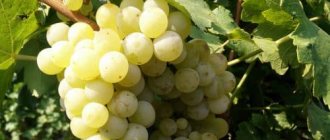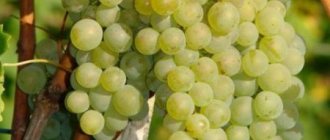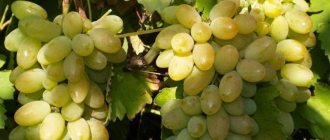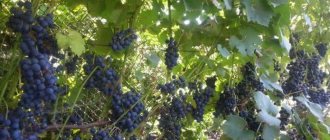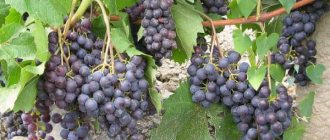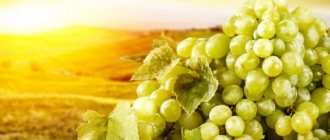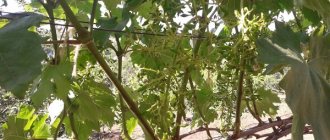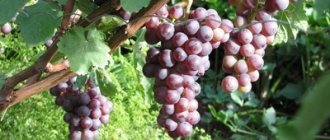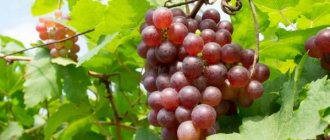Fruits and berries » Grapes
0
879
Article rating
Kira Stoletova
Winegrowers use different types of berries for different purposes. Pink dessert grapes, suitable for making wine. Externally exotic berries do not require special care.
Pink grape varieties
Varieties of culture
Pink grape varieties range from light pink to purple.
Varieties of varieties:
- Gurzuf variety;
- Dubrovsky;
- Haze;
- Kishmish pink;
- Pearl;
- Chasselas;
- peach;
- Flamingo;
- Minsky;
- Lotus;
- Traminer;
- Pink-amber;
- Dnestrovsky.
These are the main varieties of pink grapes. There are also hybrid forms and late-ripening types, but the latter are not suitable for the Russian climate in open ground. They are grown only in greenhouses. This is more complicated and requires special knowledge and skills.
Transfiguration early
This grape variety is produced from a complex interspecific grape hybrid. The bush matures in 115 days. The bunch is large, reaching 1.5 kilograms. The berries are beautiful, large in size, weighing up to 18 grams and have a nice elongated shape and a pink tint. They are attractive in appearance and pleasant in taste.
Preobrazhenie grape bushes grow very quickly and do not require any special difficulties in caring for and growing.
Preobrazhenie grapes are characterized by good resistance to frost and are well maintained during transportation. Endowed with average protection against fungal diseases. The variety is in demand among consumers.
Gurzuf variety
The Gurzuf pink grape variety is classified as a type of early ripeness. The ripening period is about 110 days. He was taken out in the city of Gurzuf, on the territory of Crimea. It is suitable for cultivation by beginning winegrowers, as it does not require special care.
Description of berries:
- clusters of medium or large size up to 300 g;
- the berries are loosely arranged and round in shape;
- have a mild nutmeg taste.
Berries contain about 30% sugar. These are large indicators for a crop, so their calorie content is higher than that of other species. Gurzuf pink loves warmth and light, so it should be grown on the south side of the site, choosing soil that is not too wet.
Appearance of grapes
It is impossible to answer this question unequivocally - since there is not one subspecies , but many, differing both in external characteristics and in taste.
The berries are usually reddish or pink, but they are also light green, covered with pink, uneven spots.
They can be cone-shaped, oval, elongated or round. The shoots are light green or reddish in color, pubescent. The leaves range from pointed to rounded, with pronounced “lobes”.
The flowers are bisexual. The skin is thick or medium thickness. The vine is deep brown in color, and the bushes are usually vigorous.
Amethyst, Moldova and Count of Monte Cristo also have bisexual flowers.
Dubrovsky
Of the pink grape varieties, this one has the largest berry size - up to 4 cm in length. Its shape is cone-shaped, the clusters are located loosely. The fruit is fleshy, juicy, inside each berry there are 1-2 large seeds.
Dubrovsky is cultivated even in the northern regions of the country, as it has increased frost resistance. It bears fruit in the second year after planting. Also in temperate climates, varieties were bred: Donskoy and Tambovsky. Their description is the same as that of the Dubrovsky species.
The best table grapes for growing in the regions
Early pink Muscat grapes, compared to other varieties, are less resistant to drought. But it is not as sensitive to soil waterlogging as white nutmeg. Shoots are sensitive to low temperatures. In steppe regions and foothills, they often suffer from late frosts in spring. Early autumn frost also harms the grapes of this variety.
Grapes are planted in the soil from mid-April to early May, or at the end of September, beginning of October. Fertile soil is poured into the planting hole, after mixing it with mineral fertilizer and manure. The cutting is inserted into a small mound made in the center of the hole. Cover it with soil to the point where growth begins. After that, the pink nutmeg seedling is watered with water and covered with a jar or cut plastic bottle.
Early pink Muscat grapes - Seeds and seedlings from NPO Gardens of Russia
Technical grape varieties 2015. Part 2 (Technical grapes 2015. Part 2)
In the first years, the soil around the bush needs to be loosened. Roots that are too thin are trimmed in early spring so that they do not inhibit the development of the entire root system. Pink muscat grapes are watered 4 times a year and mineral and organic fertilizers are applied. Pruning is carried out in early spring or late autumn.
Early pink nutmeg is prone to a number of diseases, especially of fungal origin. The most common are:
- Mildew
- Oidium
- Philoxera
- Bunch leaf roller.
In rainy autumn, the berries of this grape variety often rot. Under unfavorable conditions, gray rot can affect about 30% of rose nutmeg bushes. Mildew fungus destroys up to 40% of the crop. In general, reviews about the productivity of pink nutmeg are not bad. Proper care, timely treatment and disease prevention allow you to get a good yield.
It is best to plant pink grapes in the spring; you can also plant them in the fall, the main thing is to cover them properly for the winter.
Pink grapes love both sun and moisture. So, we plant in well-sunny areas and water regularly. It is necessary to water before and after flowering, as well as during periods of severe drought.
Fertilizers require moderate doses; potassium and phosphorus are especially useful. It is best to mulch the soil around the bushes.
Lastly, pink grapes will not develop without proper pruning. It is carried out either in early spring or in autumn, when the grapes are already dormant. Also, the bushes must be thinned out.
Varieties for regions are distinguished by ripening and frost resistance, drought resistance and soil requirements. A correctly selected variety, according to the growth characteristics and characteristics of the plant, will allow you to get a decent harvest and preserve the vine in the garden plot for more than one year.
The best early-ripening grape varieties for the Moscow region withstand frost and are not damaged by powdery mildew. Basically, these are those hybrids that easily grow on loams and heavy soils and are not demanding on temperature conditions:
- Alyoshenkin's gift,
- Helios,
- Bogatyanovsky,
- Russian Corinka,
- Libya,
- Transfiguration,
- Muromets,
- Moscow black,
- Tason,
- Julian,
- Tukay.
Kishmish
The variety does not tolerate frost
The Pink Kishmish grape is an oriental variety, bred from wild types of berries. People appreciate it because it has no seeds.
Pink raisin is a late-ripening grape, the period of full ripening is 140 days, so it is carefully planted in the north.
Despite the late ripening period, significant advantages are noted:
- Vigorous bushes.
- High yield.
- Resistance to oidium, but high risk of infection by grape budworm.
Pink Kishmish grapes also have disadvantages: they are too heat-loving and require a lot of light and high temperatures to ripen. Frost resistance is low, which does not allow it to be grown in all regions.
Diseases and pests
Resistance to fungi such as mildew and gray rot is not lower than average.
At the same time, pink grapes are a tasty trophy for wasps, sparrows, magpies, beetles, and moths. They undermine the shoots, spoil the leaves and berries. Nevertheless, it is possible to resist them.
For birds these are usually fine mesh nets, for wasps - traps and sprays, for insects and caterpillars - insecticides.
Poisons (Zone, Get, Delta-Zone) are also used against wasps, but this is, so to speak, the least humane method - more often they prefer to simply scare them away, and set traps for those who are too curious.
Wasps, in addition to harm, also bring benefits, destroying grasshoppers, aphids, and bedbugs.
You only need to choose “odorless” baits - a strong chemical “amber” will simply scare away the wasp and such a trap will be of no use.
Preparations that protect grapes from mites, leaf rollers and other moths include Trichodermin, Gaupsin, Lepidotsid, Actofid and others.
You should not lose sight of such common grape diseases as anthracnose, chlorosis, bacteriosis, rubella and bacterial canker. Preventive measures taken in time will help avoid big problems.
Pearl
This species was obtained through selection; it was bred by the Russian Institute in Michurinsk. This is a non-sheltering type of crop - it is left to overwinter without shelter if the air temperature is above -16℃. Therefore, Pearl is suitable for cultivation in the northern regions, where it is planted from June 5 to June 30.
The description of the species is as follows:
- Sugar content 25%.
- Conical bunch shape, weight up to 500 g.
- Delicate pink color of berries.
- High yield - up to 8 kg per bush.
The absence of additional shelter is possible only if there is a protective layer of snow and without temperature fluctuations.
Advantages and disadvantages
Pros:
- Early ripening.
- Unusual taste.
- High frost resistance.
- Possibility of brushes remaining on the bush for a long time without losing their taste characteristics.
- Easy to care for.
- Good yield.
- Resistance to major grape diseases.
Minuses:
- Tendency to cracking.
- Susceptibility to attacks by wasps.
- Relatively light brush weight.
Chasselas
This type of berry is used to make wine. Ripening takes place in 130 days in favorable conditions. The clusters are in the form of a cone or cylinder, large. The berries are dark pink or dark purple.
But Chasselas is not suitable for growing in the northern regions, because it has a number of features:
- reduced resistance to drought;
- does not tolerate frost;
- susceptible to fungi and infections caused by high humidity.
The species was bred in France, so it is focused on warm and sunny climates.
The vagaries and problems of Pink Muscat
The first feature of the variety is the low vigor of bush growth. Many growers may consider this a serious drawback, since this not very productive vine is slow to reach its full vigor. At the same time, any pruning of Muscat pink should be done as carefully and professionally as possible.
Others see the slow growth of this grape as an advantage:
- the vines are not prone to growing shoots that weaken the plant;
- the removed foliage that shaded the bunches will not be restored soon.
As a result, you can provide all the brushes that are collecting juice with a sufficient amount of sunlight and heat.
Despite the fact that Muscat pink flowers are bisexual and self-pollinate well, to increase the number of ovaries and prevent berries from peas in small vineyards, flowers can be cross-pollinated . Do this with a soft, dry sponge, collecting pollen from all plants on a clean plate. Then it is mixed and returned to the flowering brushes with a brush or the same sponge. This operation is quite effective and eliminates the need to use growth stimulants, as is done on large plantations.
The second feature of pink Muscat can be considered its dislike for clay soils, peat bogs, wetlands and groundwater close to the surface. In such places it simply may not take root, and if it does take root, it will wither and not produce a harvest.
Recent Entries
5 working ways to use tar in the garden 7 indoor plants that help you get married even in adulthood Indoor plants that can bloom in trouble
The third nuance is watering and natural precipitation. For this variety, both a lack of moisture and its excess are harmful. A good solution to the problem can be drip irrigation, when there is always moisture, but in small quantities. At the same time, it is recommended to mix organic and mineral fertilizers with the water from time to time, and minimal doses of stimulants during the growth period of the bush.
However, normalizing watering will not prevent rotting of the berries and the bush itself, or its infection by fungi during long, incessant rains, if they are typical for the climate of the area where Muscat Rose is planted.
Pink muscat is very susceptible to fungal diseases, so treatment with fungicides in spring and autumn is a mandatory preventive procedure for growing this variety. The same drugs can be used in the summer when a vine disease is detected. After all, it is known that when grapes are infected with a fungus, we are no longer talking about saving the harvest; the bush itself must be rescued from trouble.
As for insect pests, treating grapes with any available insecticides helps to successfully combat most of them, and timely prevention can completely eliminate this problem. The exception is phylloxera. In many cases, to protect pink Muscat from it, the only way out is to graft it onto a rootstock of a variety that is resistant to these pests.
Video about growing technical grapes by Vladimir Mayer
Flamingo
Berries do not tolerate transportation well
This species was bred abroad. It ripens late and requires sunny, warm weather. If the summer is cold, the fruit bears little or does not ripen at all. The berries are pink with a waxy coating. The average weight of a bunch is 700 g, the berries are round.
In cold and rainy summers, the berries may burst.
Because of this, Flamingos are grown primarily in private greenhouses. It is not used in industry because it does not tolerate transportation well.
What type does it belong to?
Pink varieties are very popular both in private households and in industry. This grape is suitable not only for wines - it is also used to make compotes, desserts, and in its natural form the berry is very attractive. Pink varieties have a bright but unobtrusive taste, with a strawberry hue and a rich aftertaste.
Among them, Angelica, Gurzuf pink and Flamingo are widely known.
Its popularity is also explained by the fact that it feels great not only in the southern regions, but also in Siberia. Pink grapes are also widely used to decorate hedges and house facades.
Minsky
This is a Belarusian type of crop obtained by selection. A distinctive feature is that the clusters are equalized by mass. The weight of one is about 260 g. It is dense, so the berries are often deformed, which spoils the aesthetic appearance.
Sugar up to 25%. Testers noted the following features of the view:
- High frost resistance (up to -29.6℃).
- Resistant to mildew, but prone to gray rot.
- The bushes are often overloaded with harvest; they need to be rationed.
Low transportability makes this species suitable only for growing at home. The ripening period is very early, so it is grown in temperate climates. Minsk is suitable for eating and making wine.
The Ultra Kostrikin species (also of Belarusian origin) is suitable for cultivation in the north and has similar characteristics.
The best pink varieties of universal and wine grapes
Naturally, among pink grapes there are varieties that are also suitable for fresh consumption and making wine:
The note! Gurzuf pink and Muscat pink, rather, can be classified as black (blue) varieties, because they have a dark red tint to the fruit, but it is their names that determine their place in the classification (by color).
Gurzuf pink
Universal variety.
Obtained by crossing the varieties Muscat VIRA and Magarach 124-66-26. Selection of the illegal armed group "Ampelos" (Ukraine).
Vigorous bushes with bisexual flowers.
Gurzufsky's clusters are cylindrical or cylindrical-conical, winged, medium or large in size, loose, with an average weight of about 250 g.
By the way! The taste is very similar to the Hamburg Muscat variety.
The berries are dark red. The fruits are round in shape and have a fleshy pulp. The peel of the fruit is dense. The taste is pleasant and harmonious, with a pronounced aroma of nutmeg. The number of seeds in the fruit is from 3 to 4 pieces.
Recommended for making high-quality rose dessert wines.
Characteristics of the Gurzuf pink variety:
- ripening period - (110-115 days) early;
- yield - 150 g/ha;
- sugar accumulation - 25-29%;
- acidity - 6-7 g/l;
- optimal load - up to 40 eyes;
- Recommended pruning of the vine is 2-4 buds;
- frost resistance up to -25 degrees.
Advantages:
- Good tasting score (7.9-8.0 points).
- Field resistance to common diseases (mildew, oidium, gray rot).
- Good ripening of young vines.
Minuses:
- Relatively weak resistance to phylloxera.
- The overall taste is spoiled by the thick peel, which leaves a grassy taste in the mouth.
Diana
Universal variety.
An old variety from North America.
Characterized by bushes of weak and medium vigor.
It has small whole leaves. The lower part of the leaf blades has a dense edge.
The grape bunches are cylindrical in shape, medium in size and dense in structure.
The round, small fruits are characterized by slimy pulp with a distinct isabella flavor.
Characteristics of the Diana variety:
- ripening period - mid-late September;
- frost resistance up to -30 degrees.
Advantages:
- The flowers are bisexual, so there are no problems with the ovary.
- Productivity is above average.
- It is highly resistant to fungal diseases.
- No need to cover for the winter.
Lydia (Isabella pink or red, Lydia pink)
Universal variety.
Belongs to the isabella group.
Characterized by a medium to strong growth rate.
Suitable for growing on a personal plot for landscaping a gazebo. Also suitable for landscaping balconies and house walls.
The leaves can be of different sizes and shapes (three-, five-lobed), slightly dissected, with a felt edge present at the bottom.
The clusters are medium (120-200 grams), characterized by a conical or cylindrical-conical shape, branching and loose structure.
The berries are medium (about 2-3 grams), round, dark red, with a lilac waxy coating. The skin is strong, the flesh is slimy, and there is a specific strawberry aroma.
Lydia responds well to fertilization and is not susceptible to waterlogging of the soil.
Characteristics of the Lydia variety:
- ripening period - 140-150 days;
- yield - 100-120 c/ha;
- sugar accumulation - 18-19%;
- acidity level - 5.5-9.3 g/l;
- frost resistance up to -29 degrees.
Important! The variety needs to be constantly pinched and minted, otherwise the plantings become very thick, which somewhat retards the ripening of the fruit, but in general it is very unpretentious.
Advantages:
- Has bisexual flowers.
- Does not require treatment for mildew or oidium, because has field resistance against these diseases.
- One-year shoots ripen well.
- Tolerates drought well.
- Tolerates increased moisture.
- Relatively salt resistant.
Flaws:
- Susceptible to calcareous chlorosis.
- Phylloxera resistance is insignificant.
- As the berries ripen, the stalks weaken.
Used for making dessert and strong wine materials, as well as juice.
Features of cultivation
The “Russian Early” variety is ideal for planting in the central regions and is considered a frost-resistant and unpretentious variety, which has an average presentation and has a very short shelf life.
Boarding time
“Russian early” seedlings can be planted in autumn and spring, but experienced winegrowers advise doing this at the end of the season. Overwintering young plants in the ground allows them to quickly adapt to new conditions and harden themselves properly: in the future, such bushes will be strong, resistant to adverse environmental conditions and infectious diseases.
With the onset of spring, they will immediately begin to grow. When planting in autumn, the main thing is to do it before the first frost, or rather, 2 to 3 weeks before it. This time will be enough for the young plant to acclimatize.
Place and soil
Grapes, no matter how frost-resistant they may be, are still a southern plant, so to plant them in your garden plot you should choose a place protected from drafts, which is heated by the sun during the day. It is advisable to plant “Russian early” on the southern side of the buildings, but it is important to ensure that tall trees that can shade the vineyard do not grow nearby. In addition to protection from the wind, the wall of the building at night will transfer the heat accumulated during the day to the bushes, thereby having a beneficial effect on the development of the vine.
Attention! Twice a season, the soil under the bush should be thoroughly loosened, all weeds should be removed, and the surface of the soil should be covered with mulch - peat, sawdust or humus.
“Russian Early” grows quickly, so when planting several bushes of this variety nearby, you should maintain a distance of 3 meters between them. The depth of the hole must be at least 70 cm. Its bottom must be covered with a layer of drainage, since the variety is sensitive to stagnation of moisture. It’s good if the soil on the site is fertile and loose, otherwise it needs to be enriched and made porous. This can be done by adding river sand (1/2 bucket), wood ash (500 g), and a mixture of humus (1:2) to the soil dug out of the hole.
Watering and fertilizing
Watering is an integral element of grape care. “Russian early” loves moisture, but does not tolerate stagnation of moisture in its roots, so the bush needs to be watered, but strictly according to the schedule.
- In early spring and late autumn, so-called moisture-charging irrigation is required. At the beginning of the season, it “fills” the grapes with juices, and at the end it helps the plant survive the cold winter.
- After flowering and when the berries begin to ripen, 2 more mandatory waterings are carried out.
- The following are in case of dry and hot weather. If precipitation falls systematically in summer, then you should limit yourself to the watering listed above.
Important! The water consumption rate for watering one bush is 10 - 20 liters.
There can be no talk of any rich harvest if the plant is not fertilized . Fertilizers are usually applied during watering and are carried out according to a certain scheme:
- In spring - nitrogen-containing or complex mineral fertilizers.
- When fruits begin to ripen, fertilize with potassium and phosphorus.
- In the fall, before sheltering for the winter, a complex mineral composition. Once every 2–3 years at the end of the season, organic matter should be added, but not more often, otherwise the fruits may begin to taste bitter.
Trimming
A rapidly growing plant requires annual pruning, the quality of which determines the yield and presentation of the fruit.
With the establishment of constant heat, but even before the start of sap flow, frozen and damaged vines are removed. During flowering, the yield is rationed: weak, defective brushes are removed. In autumn, the formation of a bush is carried out, starting from the second year of the plant’s life. It is possible to perform both short and medium pruning, during which 2 to 3 buds remain on each shoot.
Diseases and pests
“Russian Early” has good resistance to mildew, oidium, and all types of rot.
However, the variety has weak immunity to powdery mildew and phylloxera, and without preventive measures the plant may die within a few years. The set of necessary measures that will prevent the plant from being damaged by disease and pests should include:
- Sanitary pruning in autumn and spring with the destruction of affected shoots.
- Treatment with copper sulfate 2 times a year (10 g of powder per 10 liters of water).
- Irrigation during flowering with ash or soda.
- Growing parsley next to a vineyard.
- Be careful when watering to avoid moisture getting on the leaves of the plant.
- Treatment of bushes affected by phylloxera with insecticides Fozalon, Actellik, Fastak; A sulfur solution (100 g per 10 liters of water) will help deal with powdery mildew.
The real attack on the “early Russian” is wasps. The methods of dealing with them are simple but effective: smoke bombs, destruction of wasp nests, sweet baits with poison, special bags placed on the grapes.
Wintering
The “Russian Early” variety is characterized by high frost resistance – minus 23ºС. The crop does not need shelter if the thermometer never drops to such levels during the winter. If this does happen, even in isolated cases, then it is better to play it safe and insulate the plant.
After autumn feeding and moisture-recharging watering, the lashes are removed from the support, bent to the ground, and tied together. It is recommended to lay spruce branches under them, and on top - a covering material, for example, agrofibre and a layer of earth.
Attention! For a safe winter, it is recommended that the plant undergo a kind of hardening: the bush should spend the first frosts in an uninsulated state.
Harvest storage
Juicy berries with thin skins are not capable of long-term storage, so it is advisable to eat them immediately or send them for processing. If the required temperatures for successful storage are observed (0ºС – +5ºС), the fruits can last for about a month.
Cultivation regions
The best harvest of “Russian early” grapes can be obtained in the central part of Russia and Ukraine. Its frost resistance and short ripening period contribute to its spread to the northern regions: Siberia, the Urals, Karelia.
Reviews
The taste of Russian early is very pleasant, full, harmonious, high-sugar. Alexander, Kiev region, Balaya Church
I have been growing it for over 20 years. Until now, without any chemical treatments, it bears fruit perfectly without covering. Growth vigor is above average, overloaded with harvest. Alexey Ananyevich, Vinnitsa region.
Super early varieties for the south of Russia
The southern regions of Russia are an ideal place for growing grapes. The plant loves warm and sunny weather, so the largest and sweetest varieties are cultivated in the Rostov region, Krasnodar and Stavropol territories, and Abkhazia.
Julian
The super early variety Julian ripens in 95–105 days. The berries are used to make compotes, preserves, and jams. The clusters are loose on a long stalk, weight - from 800 g to 2 kg. The fruits are finger-shaped, oblong, berry weight is about 20 g, the color is pinkish-yellow. The pulp is crispy and homogeneous. The berries do not crack after ripening, and the thin skin is not felt when eating the fruit. The taste is pleasant berry, with a strawberry aftertaste. The bones are soft and small. Disease resistance is above average.
Elegant
The heat-loving grape variety Elegant does not require support, but does need regular pruning. The bushes have low or medium vigor, making them suitable for growing in small garden plots. Fruit ripening period is 100–110 days. The clusters are conical, weighing 400–800 g, yellow-pink in color.
Elegant's pulp is juicy, without crunch, the taste is simple, with a slight nutmeg aroma. The skin is elastic, each berry has 3 seeds. Tasting score: 4.2 points out of 5.
Attention! The varieties Tason, Baikonur, Galahad, Zabava, and Arcadia are recommended for planting in the south of Russia. They are unpretentious to grow; warm and sunny weather increases productivity.
